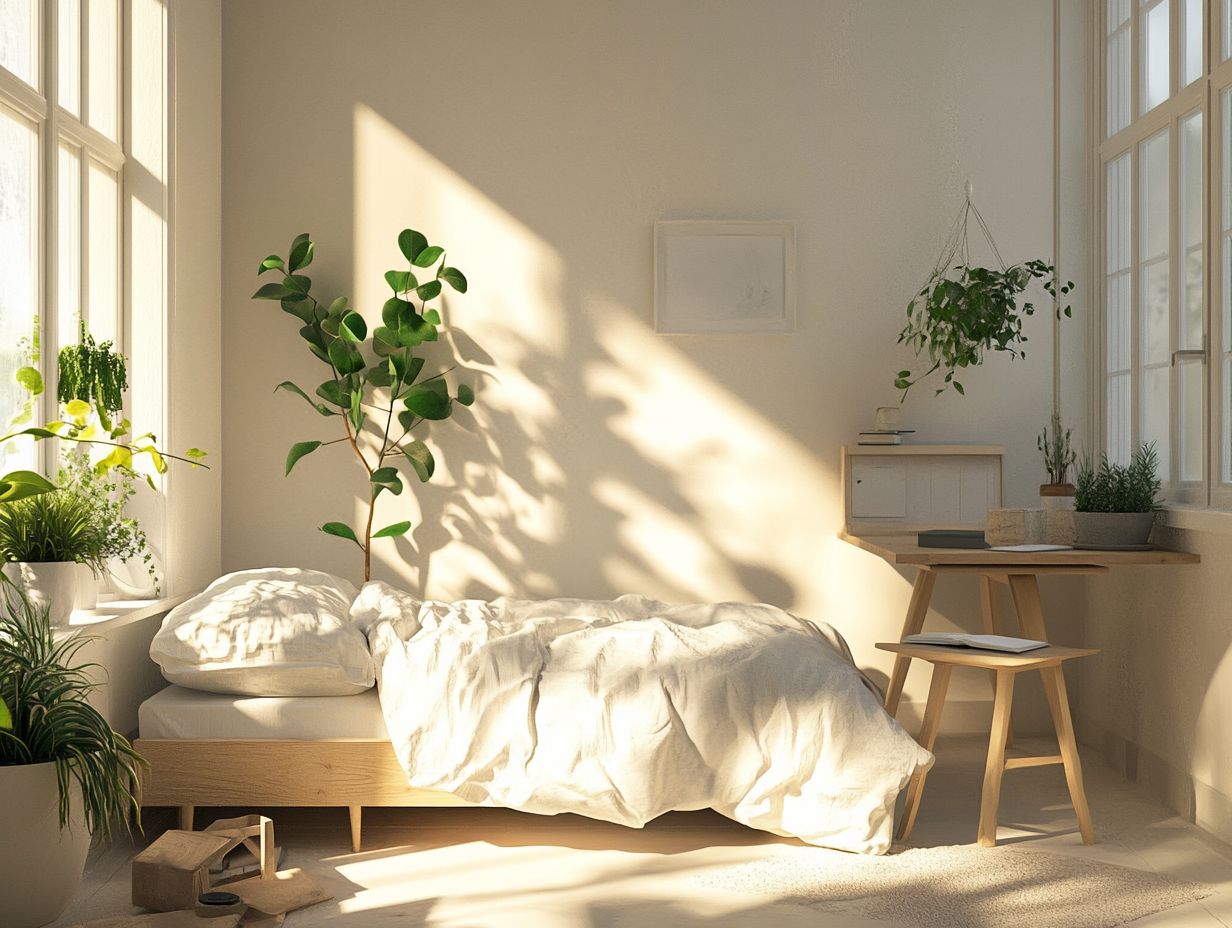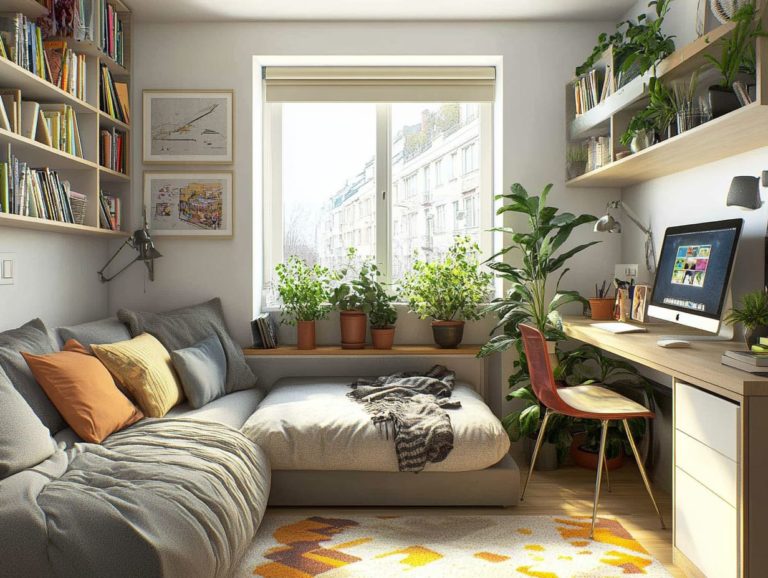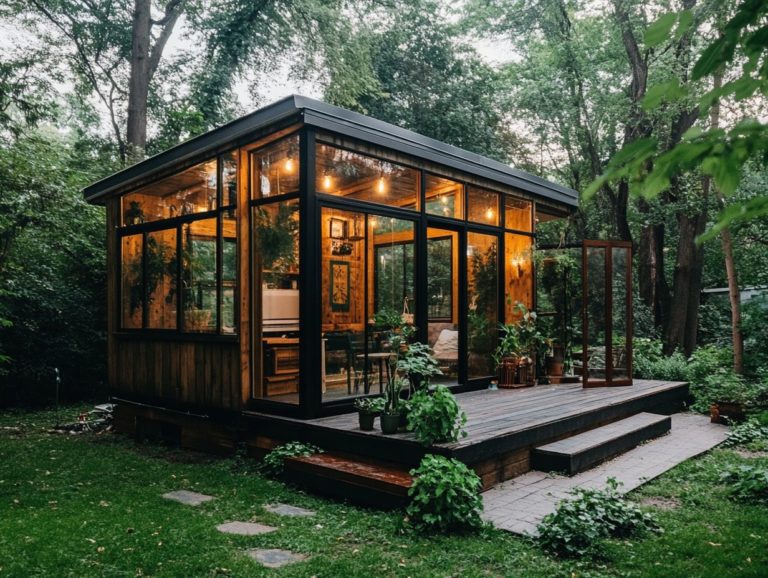7 Simple Steps to a Minimalist Tiny Lifestyle
In a world brimming with clutter and distractions, embracing a minimalist lifestyle can feel like a refreshing escape. Get ready to discover seven simple steps that will transform your space and your life!
From minimizing unnecessary possessions to welcoming multi-functional furniture into your home, these practical strategies not only foster physical simplicity but also enhance your mental well-being. You’ll also find insights into common misconceptions, the environmental benefits of minimalism, and tips on seamlessly weaving this philosophy into your daily routine.
Are you ready to uncover the transformative power of minimalism? Let s dive in!
Contents [hide]
- Key Takeaways:
- 1. Declutter Your Space
- 2. Get Rid of Unnecessary Possessions
- 3. Simplify Your Wardrobe
- 4. Embrace Multi-Functional Furniture
- 5. Limit Your Technology Use
- 6. Practice Mindful Consumption
- 7. Focus on Experiences Rather Than Material Possessions
- How Can a Minimalist Lifestyle Benefit Your Mental Health?
- Frequently Asked Questions
- What is a minimalist tiny lifestyle?
- Why should I consider a minimalist tiny lifestyle?
- What are the 7 simple steps to a minimalist tiny lifestyle?
- How do I declutter my space?
- Is a minimalist tiny lifestyle only for single people or couples?
- Do I have to live in a tiny house to have a minimalist tiny lifestyle?
Key Takeaways:

- Declutter your space for a peaceful life.
- Let go of unnecessary possessions for more space and simplicity in your home.
- Simplify your wardrobe to reduce decision fatigue and save time in the morning.
1. Declutter Your Space
Decluttering your space is essential to embracing minimalism. It allows you to live with intention and joy while forming emotional attachments only to the possessions that truly matter.
A clutter-free environment not only reduces stress but also boosts productivity, significantly enhancing your emotional well-being and personal growth.
Removing unnecessary items fosters a sense of peace and opens up pathways to financial freedom. It often reveals areas where you might be wasting money on duplicates or items you never use.
Focusing on specific areas, like your kitchen, can yield substantial benefits. By emptying cabinets and keeping only those items that serve a purpose, you can simplify meal prep and cut down on decision fatigue.
Tackling your closet encourages you to reflect on your personal style. Keep only the clothing that brings you joy or confidence. In the living room, curating cherished decor transforms the space into a comforting haven.
Ultimately, each step you take in decluttering paves the way for mental clarity and emotional liberation.
2. Get Rid of Unnecessary Possessions
Eliminating unnecessary possessions is crucial for living a successful minimalist lifestyle. It encourages you to live with less and fosters a healthier emotional attachment to the items you decide to keep.
To embark on this transformative journey, start by evaluating the role each item plays in your life. Categorize your possessions into groups: those that evoke fond memories, functional items, and those forgotten relics simply taking up space.
Recognize that letting go can significantly lighten your physical and mental load. Embracing the emotional benefits of decluttering can create a serene environment that nurtures mindfulness and creativity.
This shift encourages thoughtful consumption, prompting you to adopt a more intentional approach to future purchases. By prioritizing quality and utility over quantity, you can cultivate a healthier relationship with your material belongings.
3. Simplify Your Wardrobe
Simplifying your wardrobe by creating a capsule collection a small wardrobe made up of versatile pieces you can mix and match can truly elevate your daily routine and reflect your personal style.
This carefully curated selection usually consists of about 30 to 40 versatile pieces that can be effortlessly mixed and matched, offering endless outfit possibilities for various occasions.
Opting for high-quality basics in neutral shades allows for seamless layering and the opportunity to personalize your looks with accessories, ensuring each outfit is uniquely yours.
The emotional benefits of adopting this system go beyond mere aesthetics; it fosters a sense of clarity and tranquility. Reducing clothing clutter can significantly alleviate stress, enabling you to focus on what truly matters in your life.
Engaging in the process of selecting and styling these pieces inspires creativity, where simplicity becomes a canvas for self-expression. This approach allows you to showcase your individuality through a refined yet imaginative take on fashion.
Start your decluttering journey today and embrace a simpler, happier life!
4. Embrace Multi-Functional Furniture
Embracing multi-functional furniture is essential for living simply. It maximizes space efficiency and allows your lifestyle to flourish with intention.
Incorporating pieces like sofa beds or storage ottomans addresses both comfort and practicality. A sofa bed provides a cozy spot for relaxation and serves as a sleeping solution for guests, ensuring that every square foot in your home is purposeful.
Storage ottomans combine style and utility, offering a place to rest your feet while discreetly storing blankets, toys, or other items out of sight.
These furniture choices embody the principles of simplicity, fostering an organized environment that promotes calm and clarity. Each piece enhances the overall aesthetic without clutter, helping you cultivate a serene living space.
5. Limit Your Technology Use

Start limiting your technology use today to feel more connected! This practice is crucial for living simply, promoting mindfulness, and achieving mental clarity.
Implement strategies like setting specific time limits for device usage to regain control over your time and develop healthier habits. Create tech-free zones in your home, such as the dining area or bedroom, to encourage meaningful interactions with family members and nurture a more peaceful environment.
Embrace mindfulness practices to improve your relationship with technology. This reduces distractions and fosters personal growth and productivity. By adopting this balanced approach, you can transform technology into a valuable tool for enhancement rather than a source of dependence.
6. Practice Mindful Consumption
Practicing mindful consumption is essential as you embrace minimalism. It encourages careful buying habits that prioritize emotional value and financial benefits over impulsive spending.
Understanding the difference between needs and wants enables you to make informed decisions. Ensure each purchase aligns with your values and lifestyle. Evaluating items based on their long-term utility rather than the fleeting thrill of immediate gratification helps cultivate lasting satisfaction.
This intentional approach not only keeps material possessions to a minimum but also reduces clutter in your living spaces. Tracking your purchases and reflecting on their necessity can deepen your appreciation for what truly enriches your life, fostering a healthier relationship with money and your belongings.
7. Focus on Experiences Rather Than Material Possessions
Focus on experiences that bring lasting joy and happiness! This transformative aspect of minimalism enhances your emotional health and overall well-being.
Embracing this philosophy allows you to cultivate deeper connections with yourself and others, leading to richer, more meaningful interactions. Engaging in travel opens avenues for personal growth and intercultural understanding. Immersing yourself in community involvement nurtures a sense of belonging and purpose.
Diving into creative pursuits provides an outlet for self-expression and instills a sense of accomplishment and mental clarity. By prioritizing these experiences, you align closely with the principles of intentional living, paving the way for a life brimming with authentic fulfillment and happiness.
How Can a Minimalist Lifestyle Benefit Your Mental Health?
Adopting a minimalist lifestyle can profoundly enhance your mental health, reducing stress, fostering happiness, and promoting overall wellness. This approach allows you to focus on what truly matters in your life.
Embracing minimalism encourages you to declutter not just your physical spaces but also your mind. This leads to decreased anxiety and improved emotional resilience. Research shows that tiny home living: embracing minimalism can lower stress hormone levels, fostering a sense of calm and clarity that you may not have thought possible.
Experts, like Jackie French Koller, emphasize simplifying your surroundings to cultivate a more tranquil mindset. In her book, “Soulful Simplicity,” Koller highlights the significance of prioritizing meaningful experiences over material possessions. This shift truly enriches your life and paves the way for a healthier, more balanced existence.
What Are the Challenges of Adopting a Minimalist Lifestyle?
Adopting a minimalist lifestyle presents a wealth of benefits, yet it also brings challenges, particularly when grappling with emotional attachments to possessions and changing how you live.
You may find yourself wrestling with the fear of letting go, believing that your belongings define who you are or hold significant sentimental value. Societal pressures can amplify this struggle, as entrenched norms of consumerism and material wealth tug at your sense of identity.
To help you overcome these obstacles, start small tackle one area at a time for manageable progress and reflection.
Engaging with a community of like-minded individuals can provide essential support and encouragement. In such a positive environment, sharing experiences and strategies to create a multi-functional tiny home becomes second nature, making your journey toward minimalism not only more approachable but also deeply fulfilling.
How Can You Incorporate Minimalism into Your Daily Routine?

Incorporating minimalism into your daily routine means making mindful choices that prioritize simplicity and intentional living, ultimately leading to a more organized and fulfilling life.
By streamlining your morning routine, you can enjoy a stress-free start to the day. Lay out your clothes the night before or opt for a simple breakfast that requires minimal preparation. Meal planning is another excellent strategy; it saves time and helps reduce food waste while promoting healthier eating habits. Imagine preparing a week s worth of straightforward meals in advance.
Embracing decluttering techniques, such as the one in, one out rule, encourages a mindful approach to your possessions. This fosters a sense of calm and clarity in your home. These small, deliberate choices can create a ripple effect, enhancing your mental clarity and overall well-being.
What Are Some Common Misconceptions About Minimalism?
Common misconceptions about minimalism often cloud its true essence, leading you to believe it equates to deprivation rather than an enriching lifestyle grounded in simplicity and intentional choice.
In reality, minimalism invites comfort and aesthetic value into your life, allowing you to curate your surroundings in a way that reflects your personal tastes and elevates your daily experiences. It encourages you to clear away clutter, including not just physical items but also mental distractions. For those living in smaller spaces, tips for decluttering your tiny house can promote clarity and mindfulness.
By concentrating on what truly matters, you can cultivate a joyful and purposeful life filled with meaningful relationships and experiences. This practice doesn t demand a sacrifice of beauty for practicality; rather, it celebrates the harmony between the two, creating spaces that are both soothing and inspiring.
Start your minimalist journey today!
How Can Minimalism Help the Environment?
Minimalism can profoundly benefit the environment by fostering sustainable consumption patterns and significantly reducing overall waste. This effectively counters the impacts of consumerism on our planet.
When you embrace a minimalist lifestyle, you naturally begin to prioritize quality over quantity. This shift encourages you to choose environmentally friendly products with a lower ecological footprint.
As you make this transition, you’ll notice a decrease in unplanned buys, which are often fueled by marketing and societal pressures. This allows for more mindful decision-making.
Rather than collecting unnecessary items, invest in durable, sustainable goods. These meet your needs without harming the environment.
As you consume less, you’ll produce less waste. This leads to cleaner ecosystems and healthier communities.
What Are the Different Types of Minimalism?
There are various types of minimalism that you can adopt, each designed to promote personal growth and sustainable living while reflecting your unique approach to embracing less.
Digital minimalism invites you to reevaluate your technology use. It steers you toward meaningful online interactions that enrich your life instead of cluttering it.
Aesthetic minimalism highlights the beauty of simplicity, encouraging you to thoughtfully curate your living spaces and possessions. This ultimately fosters a sense of tranquility.
Meanwhile, sustainable minimalism focuses on being aware of our environment. It prompts you to select eco-friendly products and practices that align with your values.
By embracing these diverse forms of minimalism, you can craft a lifestyle that reduces distractions and excess while deepening your connection to what truly matters.
Frequently Asked Questions
What is a minimalist tiny lifestyle?

A minimalist tiny lifestyle focuses on simplicity, sustainability, and reducing material possessions to only what is essential.
Why should I consider a minimalist tiny lifestyle?
Imagine saving money while enjoying a simpler life with a minimalist tiny lifestyle!
What are the 7 simple steps to a minimalist tiny lifestyle?
The 7 simple steps to a minimalist tiny lifestyle are:
- Decluttering
- Downsizing your space
- Simplifying your daily routine
- Being mindful of your purchases
- Focusing on experiences rather than possessions
- Adopting sustainable habits
- Continuous evaluation and improvement
How do I declutter my space?
To declutter your space, start by sorting your possessions into categories. Get rid of duplicates, unused items, and anything that no longer brings you joy. Be intentional about what you choose to keep and only keep what is essential.
Is a minimalist tiny lifestyle only for single people or couples?
No, a minimalist tiny lifestyle can be adapted for families as well. It may require more planning and organization, but the benefits of living simply and sustainably can positively impact the entire family.
Do I have to live in a tiny house to have a minimalist tiny lifestyle?
No, a minimalist tiny lifestyle can be practiced in any living space, whether it’s a small apartment, a traditional house, or a tiny house. It’s about making intentional choices to live with less and focus on what truly matters to you.
Start embracing minimalism today and discover the freedom that comes with less!





